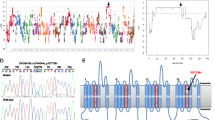Abstract
Spinocerebellar ataxia 13 (SCA13), initially described in a four-generation French family, has now also been characterized in a large Filipino pedigree. Ongoing investigations continue to identify additional SCA13 families and individuals. Recently, studies have shown that mutations in the voltage-gated potassium channel KCNC3 are causative for SCA13. Sequence analysis of KCNC3 revealed mutations 1554G→A (R420H) in the Filipino and 1639C→A (F448L) in the French pedigrees. Both mutations alter KCNC3 function in a Xenopus laevis oocyte expression system. KCNC3 R420H, located in the voltage sensor of the channel, has no detectable channel activity when expressed alone, and strong dominant negative effects when coexpressed with wild-type KCNC3. KCNC3 F448L shifts the activation curve in the negative direction and causes an approximately sevenfold slowing of channel closure. These mutations are expected to change the output characteristics of fast-spiking cerebellar neurons, where KCNC channels confer capacity for high-frequency repetitive firing.


Similar content being viewed by others
References
Herman-Bert A et al (2000) Mapping of spinocerebellar ataxia 13 to chromosome 19q13.3-q13.4 in a family with autosomal dominant cerebellar ataxia and mental retardation. Am J Hum Genet 67:229–235
Waters MF et al (2005) An autosomal dominant ataxia maps to 19q13: allelic heterogeneity of SCA13 or novel locus? Neurology 65(7):1111–1113
Waters MF, Minassian NA, Stevanin G, Figueroa KP, Bannister JPA, Nolte D, Mock AF, Evidente VG, Fee D, Müller U, Dürr A, Brice A, Papazian DM, Pulst SM (2006) Mutations in the voltage-gated potassium channel KCNC3 cause degenerative and developmental CNS phenotypes. Nat Genet 38(4):447–451
Yellen G (2002) The voltage-gated potassium channels and their relatives. Nature 419:35–42
Gutman GA et al (2003) International union of pharmacology. XLI. Compendium of voltage-gated ion channels: potassium channels. Pharm Rev 55(4):583–586
Martina M, Yao GL, Bean BP (2003) Properties and functional role of voltage-dependent potassium channels in dendrites of rat cerebellar Purkinje neurons. J Neurosci 23:5698–5707
Rudy B, McBain CJ (2001) Kv3 channels: voltage-gated K+ channels designed for high-frequency repetitive firing. Trends Neurosci 9:517–526
Goldman-Wohl DS, Chan E, Baird D, Heintz N (1994) Kv3.3b: a novel Shaw type potassium channel expressed in terminally differentiated cerebellar Purkinje cells and deep cerebellar nuclei. J Neurosci 14:511–522
Weiser M, Vega-Saenz de Miera E, Kentros C, Moreno H, Franzen L, Hillman D, Baker H, Rudy B (1994) Differential expression of Shaw-related K+ channels in the rat central nervous system. J Neurosci 14:949–972
Brooke RE, Atkinson L, Edwards I, Parson SH, Deuchars J (2006) Immunohistochemical localisation of the voltage gated potassium ion channel subunit Kv3.3 in the rat medulla oblongata and thoracic spinal cord. Brain Res 1070:101–115
Aggarwal SK, MacKinnon R (1996) Contribution of the S4 segment to gating charge in the Shaker K+ channel. Neuron 16:1169–1177
Shieh CC, Klemic KG, Kirsch GE (1997) Role of transmembrane segment S5 on gating of voltage-dependent K+ channels. J Gen Physiol 109:767–778
Smith-Maxwell CJ, Ledwell JL, Aldrich RW (1998) Uncharged S4 residues and cooperativity in voltage-dependent potassium channel activation. J Gen Physiol 111:421–439
Seoh SA, Sigg D, Papazian DM, Bezanilla F (1996) Voltage-sensing residues in the S2 and S4 segments of the Shaker K+ channel. Neuron 16:1159–1167
Matsukawa H, Wolf A, Matsushita S, Joho R, Knöpfel T (2003) Motor dysfunction and altered synaptic transmission at the parallel fiber–Purkinje cell synapse in mice lacking potassium channels Kv3.1 and Kv3.3. J Neurosci 23:7677–7684
McMahon A et al (2004) Allele-dependent changes of olivocerebellar circuit properties in the absence of the voltage-gated potassium channels Kv3.1 and Kv3.3. Eur J Neurosci 12:3317–3327
McKay BE, Turner RW (2004) Kv3 K+channels enable burst output in rat cerebellar Purkinje cells. Eur J Neurosci 20:729–739
Goldman-Wohl DS, Chan E, Baird D, Heintz N (1994) Kv3.3b: a novel Shaw type potassium channel expressed in terminally differentiated cerebellar Purkinje cells and deep cerebellar nuclei. J Neurosci 14:511–522
Weiser M et al (1994) Differential expression of Shaw-related K+channels in the rat central nervous system. J Neurosci 14:949–972
Ruppersberg JP et al (1991) Regulation of fast inactivation of cloned mammalian IK(A) channels by cysteine oxidation. Nature 352:711–714
Vega-Saenz de Miera E, Rudy B (1992) Modulation of K+ channels by hydrogen peroxide. Biochem Biophys Res Commun 186:1681–1687
Duprat F (1995) Susceptibility of cloned K+ channels to reactive oxygen species. Proc Natl Acad Sci USA 92:11796–11800
McKay BE, Turner RW (2005) Physiological and morphological development of the rat cerebellar Purkinje cell. J Physiol 567:829–850
Author information
Authors and Affiliations
Corresponding author
Rights and permissions
About this article
Cite this article
Waters, M.F., Pulst, S.M. SCA13. Cerebellum 7, 165–169 (2008). https://doi.org/10.1007/s12311-008-0039-7
Published:
Issue Date:
DOI: https://doi.org/10.1007/s12311-008-0039-7




